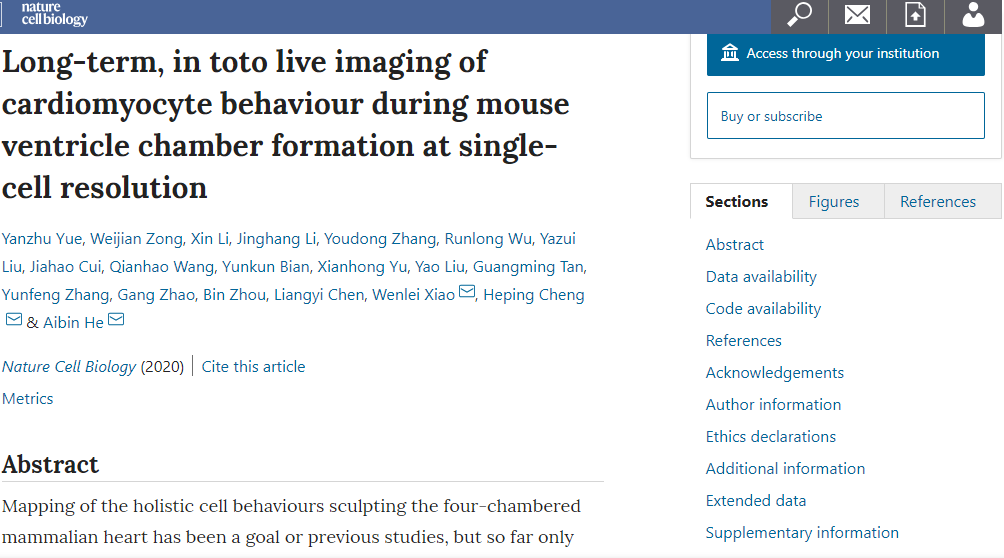On March 2, Nature Cell Biology published an article titled “Long-term, in toto live imaging of cardiomyocyte behavior during mouse ventricle chamber formation at single-cell resolution”, a joint effort by the interdisciplinary team composed of researchers from Key Laboratory of Intelligent Manufacturing Technology for High-end Aerospace Equipment (Ministry of Industry and Information Technology), Beihang University and Institute of Molecular Medicine of Peking University. Associate Prof. Xiao Wenlei of Beihang University, Prof. Cheng Heping and Researcher He Aibin of Peking University are the corresponding authors.

A central theme in organogenesis is how cell lineages of divergent sources are spatiotemporally deployed to assemble complex organ structures in mammals. In particular, the formation of mammalian heart as the first functional organ, is the key driving force for other tissues and organs. There are three main difficulties in generating uninterrupted whole-cell lineages during heart development: 1) in vitro culture of mammalian embryos, how to achieve continuous long-term and real-time live imaging and normal embryo development; 2) due to the heterogeneous nature of cardiomyocytes (CMs) as well as characteristics of large field of view (FOV) and penetration depth, how to accomplish in toto imaging and process massive image data to precisely identify CMs and track lineages; 3) the mouse fetal heart rate being 200 beats per minute (bpm), what techniques and strategies should be used to obtain images on beating heart at single-cell cellular resolution.
The research overcomes the above-mentioned challenges. In the research, the team of Beihang University is mainly responsible for the preprocessing of massive image data and the design and development of cell identification algorithm. The huge amount of initial data (~2T/day) from each trail of cardiac imaging has put forward high requirements for image processing. With the integrative approach, the team realized 36-h, all-cell-resolved imaging of the developing mouse heart at 3-min intervals. Their pipeline achieved an average segmentation accuracy of 99.68% and a lineage linkage accuracy of 99.12%. After system integration (Fig. 1), the team realized imaging of developing mouse hearts with uninterrupted cell lineages by robustly segmenting and accurately locating ~20,000,000 cells of different shapes and intensities in ~7,200 volumetric stacks (obtained over 1.5 d at 3-min intervals).

Fig.1 Live-imaging system for long-term recording of the developing mouse heart at single-cell resolution
The result reveals the cellular dynamics of ventricular morphogenesis as well as the cellular origins and mechanisms of cardiac trabeculae. The dual mechanisms of trabeculation was illustrated for the first time. Type 1 represents earlier cell fate segregation of CMs between compact and trabecular layers, which inhabit and self-expand in the trabecular layer. Type 2 represents CMs originating from the outer layer initiated in the compact layerbut ends up inthe trabeculae by oriented cell division and directional cell migration (Fig.2).

Fig.2 Cellular origins and mechanisms of cardiac trabeculae
The Key Laboratory of Intelligent Manufacturing Technology for High-end Aerospace Equipment (Ministry of Industry and Information Technology) has long been engaged in the research of CAD/CAM, intelligent numerical control, industrial robot simulation, intelligent assembly technology and equipment in the aerospace field. The research successfully applied the results on complex geometric modeling, rapid image processing and mass data visualization to the identification and pedigree tracking of massive biological images, which greatly improved the identification accuracy. It reflects the successful use of aerospace techniques in the field of biology.
Video 1 Recording of the mouse embryonic cardiogenesis
Video 2 Recording of the mouse embryonic heart ventricle morphogenes
More information of the research:
https://www.nature.com/articles/s41556-020-0475-2
Reported by Liu Jimeng
Reviewed by Deng Yi
Edited by Jia Aiping
Translated by Zhao Yue

